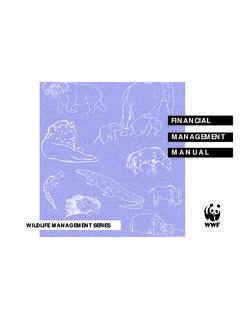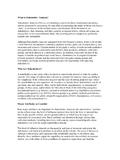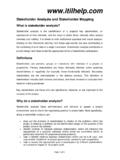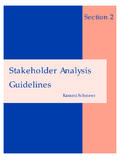Transcription of Stakeholder power analysis - Power tool
1 We acknowledge the support of The Netherlands Ministry of Foreign Affairs (DGIS) and the German Federal Ministry for Economic Cooperation (BMZ) who have financed the development of these tools, and the UK Department for International Development (DFID) who provided the start-up support. For more information on Power Tools please visit Stakeholder Power analysis March 2005 James Mayers has steered the development of this tool, from work in the forestry and land use sector. 2 Summary Stakeholders are the people who matter to a system.
2 Stakeholder Power analysis is a tool which helps understanding of how people affect policies and institutions, and how policies and institutions affect people. It is particularly useful in identifying the winners and losers and in highlighting the challenges that need to be faced to change behaviour, develop capabilities and tackle inequalities. There are various approaches to Stakeholder Power analysis . A six-step process seems to work well: 1. Develop purpose and procedures of analysis and initial understanding of the system 2. Identify key stakeholders 3.
3 Investigate stakeholders interests, characteristics and circumstances 4. Identify patterns and contexts of interaction between stakeholders 5. Assess stakeholders Power and potential roles 6. Assess options and use the findings to make progress Like other tools, the usefulness and strength of Stakeholder Power analysis depends on the way it is used. It can be carried out by individual analysts, multi- Stakeholder processes, or some intermediate between these two ends of the spectrum. Stakeholder Power analysis can be used progressively to empower important but marginalised groups, and to improve policies and institutions.
4 But it should be recognised that the techniques can also be used more cynically by some - to work out who should be manipulated, undermined or disposed of. Progressive users should be aware that the cynics may be ahead of the game, and encourage all involved to be clear about their purpose, intentions and desired outcomes. What is Stakeholder Power analysis ? People in all sorts of situations assess the positions of others on a given issue, to enable them to gauge the level of support or opposition from others, and predict how they will behave if a change is made.
5 Stakeholder Power analysis is an organised approach to this. It is an approach for understanding a system by identifying the key actors or stakeholders in the system, and assessing their respective interests in, or influence on, that system. Stakeholder Power analysis is particularly useful for assisting in decision-making situations where various stakeholders have competing interests, resources are limited, and Stakeholder needs must be appropriately balanced. As well as evaluating existing policies and institutions, it can be used to appraise possible scenarios.
6 It is about asking questions like: Whose problem? Who benefits? Who loses out? What are the Power differences and relationships between stakeholders? What relative influence do they have? analysis of answers to these questions enables the identification of institutions and relationships which need to be developed or dealt with to avoid negative outcomes and enhance positive ones. Why and when to use Stakeholder Power analysis may be a key tool for improving livelihoods. If for example the focus is on improving a livelihood strategy then this generally requires an increase in the capability or empowerment of the person pursuing it - the primary Stakeholder .
7 This in turn requires a change in the relationship between this person and other stakeholders, and in the benefits derived from it. Policies and institutions usually shape, and often determine, these relationships between stakeholders. If these policies and institutions are to be geared towards improving livelihoods then understanding the individuals and groups that affect them, or are affected by them, is crucial at all levels. Thus, following some initial steps to understand which policies, institutions and processes 3 matter for livelihoods, the nature of each needs to be uncovered.
8 Often the picture is complex and Stakeholder Power analysis provides a means to start understanding it1. The complexity of many livelihoods makes it unlikely that there will be a generalised solution - a set of policies, institutions and processes - to meet everyone s needs. Stakeholder Power analysis can help understanding of the distribution of costs and benefits ( between rich and poor, men and women), why things are the way they are, and what needs to change. Stakeholder Power analysis may be used at a variety of levels and purposes: Broad-level strategic process - to scope, build momentum and monitor a process Institution or business - to examine the health of an organisation and plan changes Project or programme to design, steer and monitor a project Particular decision to predict the consequences of a decision, and plan to deal with them It is increasingly recognised that good policies and institutions are 'owned' by a broad range of stakeholders - not just the most prominent, or powerful, Stakeholder group.
9 Stakeholder Power analysis can in itself provide a step towards improving policies and institutions, depending on the degree of involvement of relevant decision-makers in the Who are the stakeholders? Stakeholders are those who have rights or interests in a system. If you are concerned with the future of a system the stakeholders are those you should worry about. For an organisation, for example, stakeholders are any group or individual who can affect, or is affected by the achievement of the organisation s purpose. This definition is too broad for some as it includes interested parties as well as affected parties.
10 Some prefer to restrict the term to those who have a stake , claim or vested interest those who provide something of importance to the organisation, and expect something in return. Stakeholders can be individuals, communities, social groups, or organisations. For example, stakeholders in a forest policy might include people who live in or near the relevant forests, people who live further away who use these forests, settlers from elsewhere in the country, or abroad, workers, small scale entrepreneurs, forest officials, timber company managers, environmentalists, politicians, public servants, national citizens, consumers, forest authorities, central government agencies, local government agencies, national NGOs, academics and researchers, donors, consultants, international NGOs.








